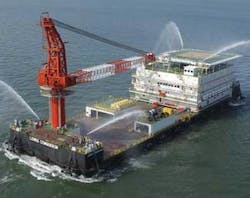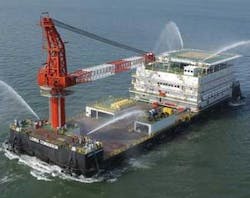When specs get tougher, so does the crane designer/manufacturer
Jay Schempf, Special Correspondent
During the last several years, as the offshore petroleum industry has moved drilling and production, and therefore service and construction equipment, into deeper water, groups concerned with industry standards and practices have placed significantly more emphasis on the safety and reliability of the load-handling gear placed aboard such vessels and structures.
This is particularly true with regard to the employment of pedestal cranes on deepwater drilling and construction vessels and those used on both floating and fixed production facilities.
As a result, at the dawn of the 21st century, the American Petroleum Institute (API) - acknowledged as the industry’s chief technical standards organization - conducted a major re-write of a number of its specifications for offshore equipment. Among these were significant changes to API Specification 2C for offshore pedestal-mounted cranes.
These beefed-up crane standards, now contained in the sixth edition of API’s official codes and practices, are the most stringent in the world. The result has been that crane designers and manufacturers have instituted significant design changes and equipment reconfigurations to meet them.
One of the first
One such crane designer/manufacturer, Seatrax Inc., Houston, was among the first to inaugurate an API 2C modifications program. According to John Hale, Seatrax’ Vice President of Sales and Marketing, Seatrax did so - far in advance of the new requirements, which went into effect in September 2004.
Seatrax is engaged in the engineering, design and manufacturing of pedestal cranes for marine operations, as well as rugged hoisting equipment used by a wide range of industries
Hale said that by anticipating API 2C requirements, the company made substantial contributions to the safety and reliability of its pedestal cranes. Seatrax has more than 750 such cranes in operation around the world, he said, basing product development on the time-proven “kingpost” concept for pedestal cranes.
The most significant features of the revised API Specification 2C, Sixth Edition, include, among others:
- Provision of specific design/ratings guidelines for cranes on floating installations.
- Provision of specific guidelines for crane purchaser safety-in-design assessment.
With regard to the design/ratings guidelines, API 2C provides specific engineering values for engineers to use in the design and manufacturing process, tailoring it to the kind of structure for which the crane application is intended. “Under API 2C, a given crane would typically have different safe working load ratings, given the type of facility upon which it is installed,” Hale said.
As for the crane purchaser’s safety-in-design assessment guidelines, the standard provides a specific means with which to calculate the failure mode of critical structural components of the crane, and provide a safety assessment to confirm that the entire crane will not separate from its foundation.
“A ‘failure mode assessment’ must be provided if the purchaser requests it,” Hale noted. “Nevertheless, the requirement states specifically that neither the slew (lower) bearings and its fasteners, nor the pedestal or kingpost, shall be the first to fail. And the crane design must be such that the components supporting the crane operator also must not be the first to fail.”
Additionally, he said, in recognizing a floating installation’s impact on the mounted crane during its respective lifting operation, the revised standard states that the crane’s “swing” torque can be a limiting factor to its published load charts.
The crane must be able to swing and hold the loads as stated on the load chart, but not without factoring-in such data as vessel tilt and accelerations, as well as off-lead and side-lead forces.
“In other words, the crane may be capable of lifting the load, but it must be able to handle the load dynamically, as well,” said Hale.
All series in compliance
According to Hale, the design of Seatrax’ “S” Series cranes, from the smallest Series 42 (20-ton capacity) through the large Series 126 (500-ton capacity) meet and in many cases exceed API 2C requirements. The company currently produces all models.
“The acceptance of the “S” Series by customers throughout the world has again proven that Seatrax is committed to providing the world’s safest and most dependable crane products,” Hale said. He added that every system on a Seatrax crane is designed and engineered to adhere to exacting customer specifications and that it meets or exceeds all applicable international design codes and classification society requirements.
“With manufacturing facilities in both the U.S. and the UK, Seatrax delivers an uncomplicated and easily-maintained offshore crane that is cost-effective to own and operate,” he said.
For more information on Seatrax kingpost pedestal crane products, contact John R. Hale, Vice President, Sales and Marketing; telephone: 713-896-6500, Ext. 30; fax: 713-896-6611. E-mail:[email protected]. Website: www.seatrax.com.

